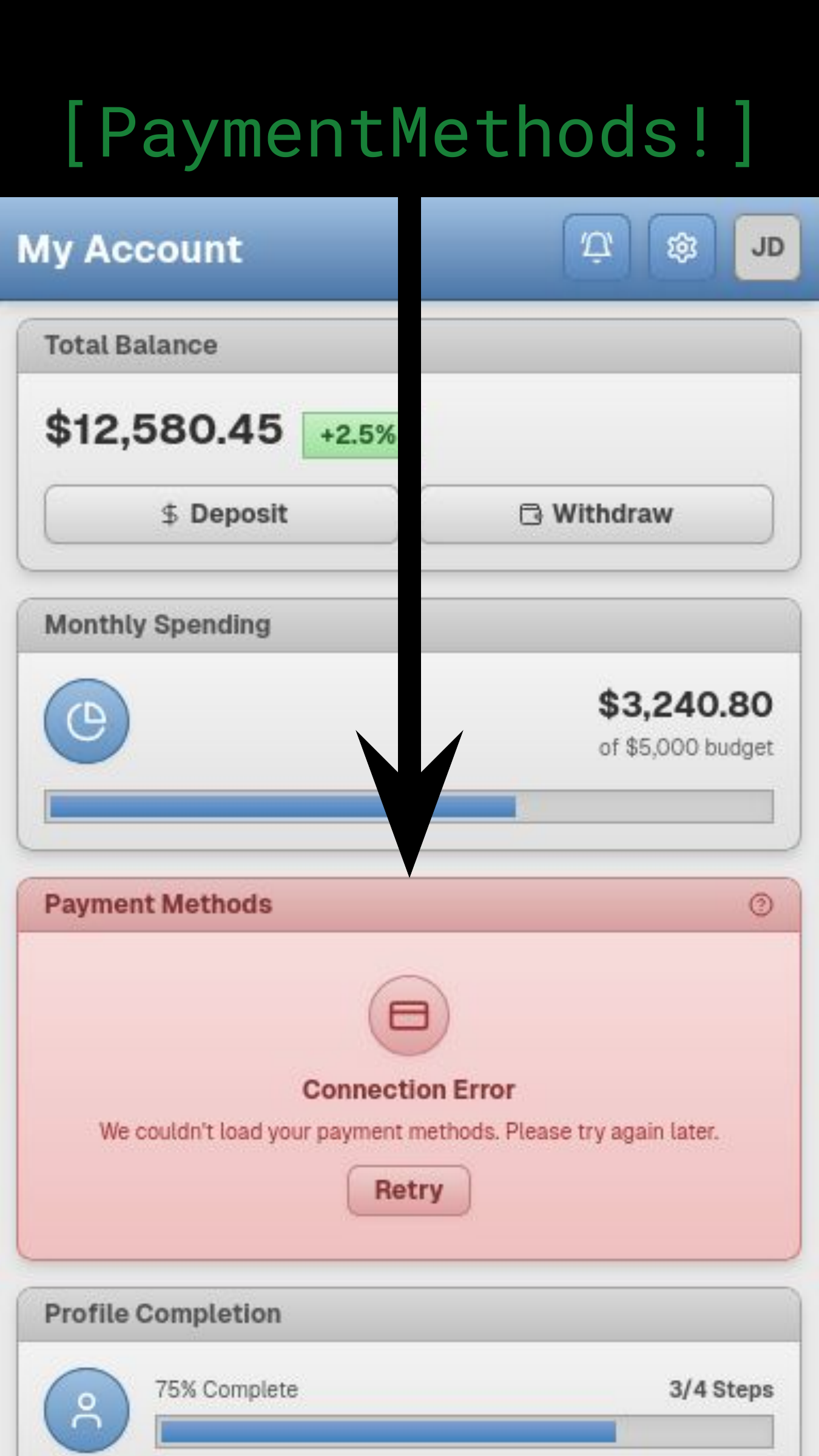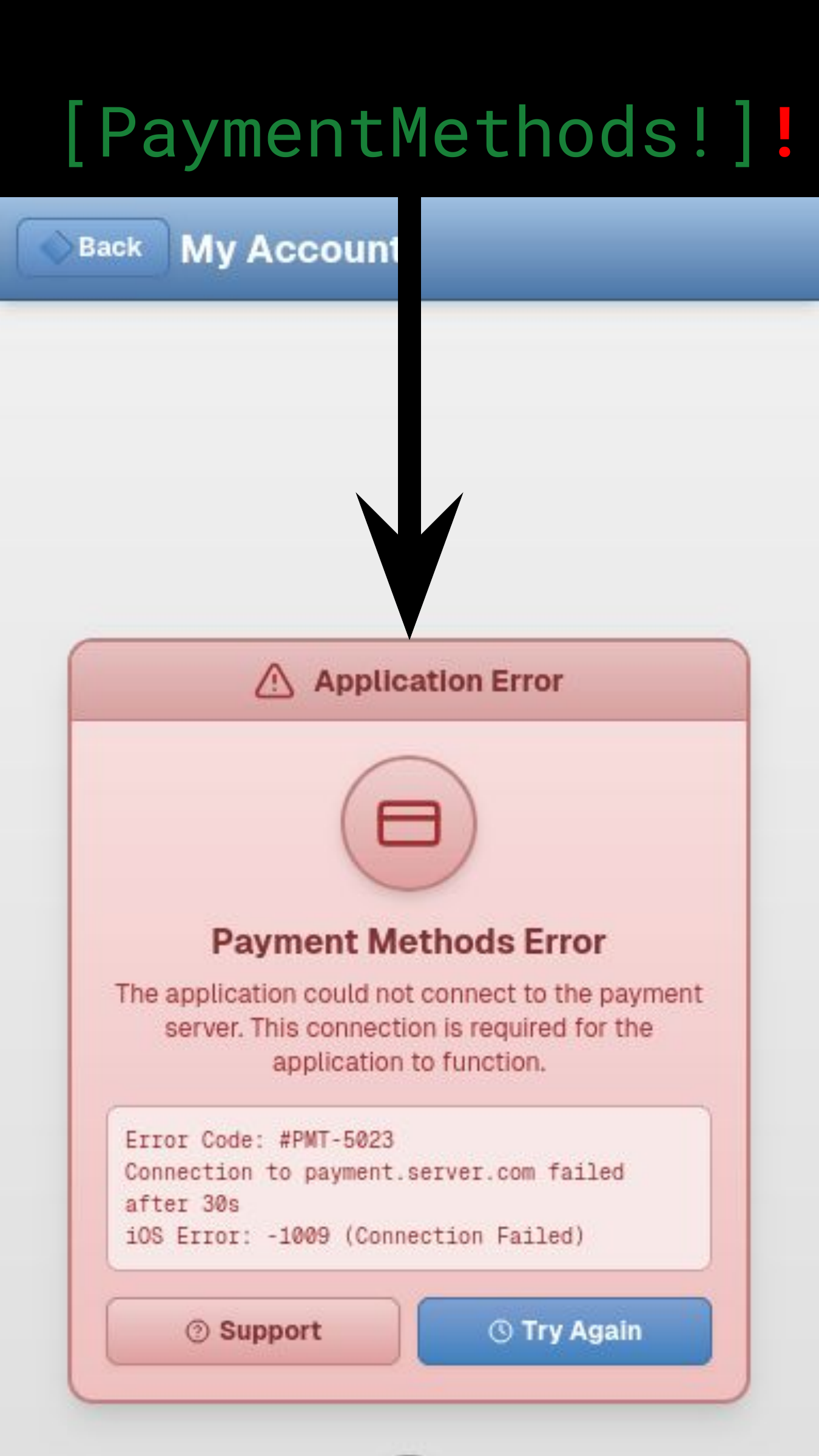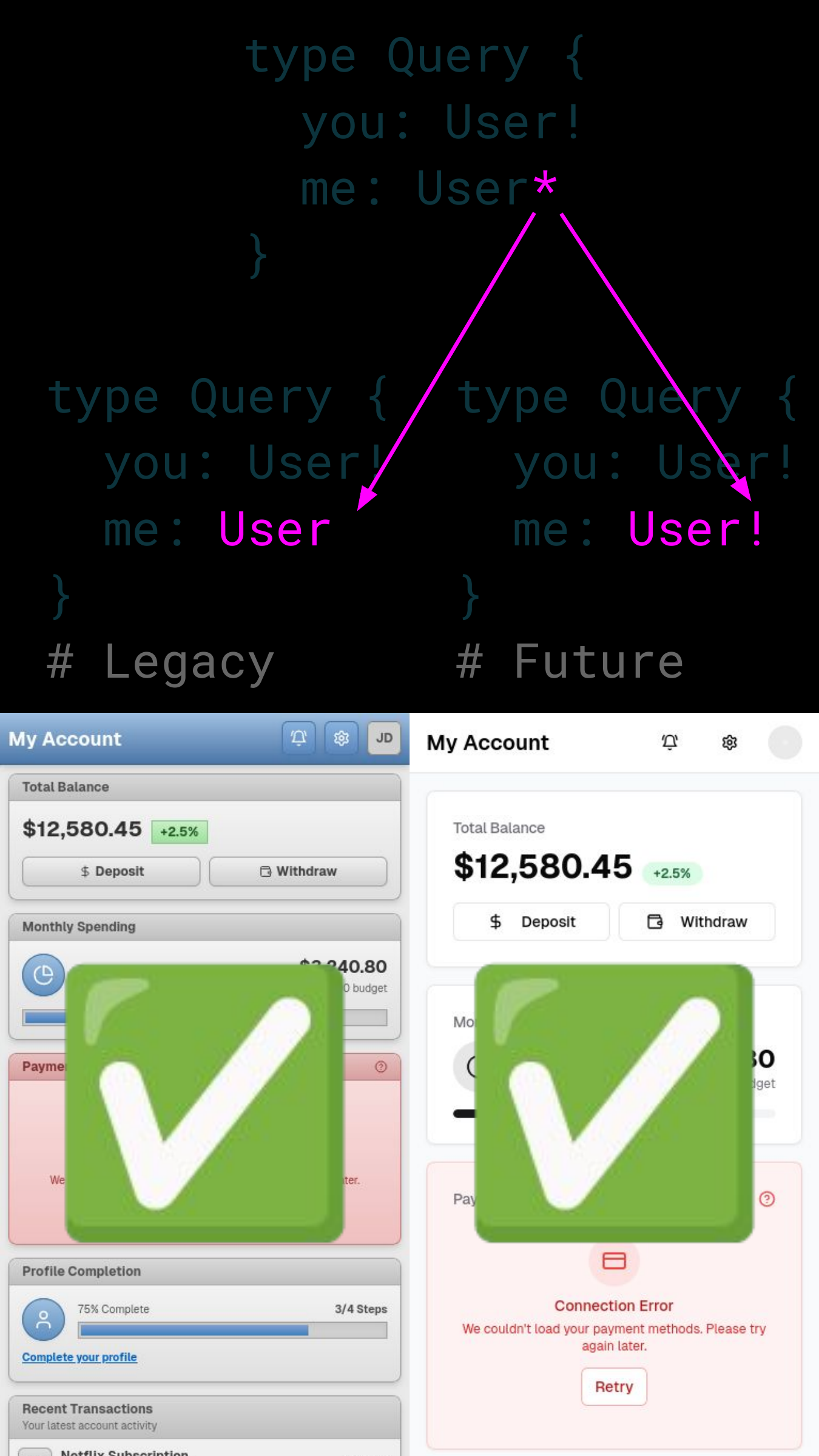Nullability
This article reflects Benjie's opinions on the past and the future of Nullability in GraphQL; but note that these are merely opinions.
Here's a 60 second summary of this article:
The status quo
⏩ Jump to Handling errors on the client for the proposed changes to GraphQL.
By default, data doesn't exist
In mathematics and in many programming languages we use null to represent data
that doesn't exist (let's not get into JavaScript...).
The original SQL standard factored this knowledge into its design, so an int
column in SQL means "an integer or null". To represent a non-nullable integer
you would add a type narrowing constraint, such as int not null. This pattern
of the type including null unless otherwise constrained is called "nullable by
default".
GraphQL is similar, types are nullable by default. To narrow a type to exclude null, we add a "non null" wrapper, indicated in the GraphQL language by an exclamation point:
type User {
name: String! # Definitely a string, never null
}
type Query {
you: User! # Definitely a User, never null
}
Partial success
Resiliency was a key design goal of GraphQL. When working on the newsfeed, Facebook wanted to ensure that any temporary interruptions in one part of the system would not impact on other parts and cause user outages. Instead, they wanted GraphQL to enable "partial success" where as much data as possible would be rendered to the user.
To enable this resiliency, when GraphQL meets an error it notes where it was,
adds it to the "errors" list, and replaces the output data with null:
Schema and query (click to show/hide)
type Query {
you: User!
me: User
}
query Q {
you {
name
}
me {
name
}
}
{
"data": {
"you": {
"name": "Jo"
},
"me": null // < An error occurred, see `errors`
},
"errors": [
{
"path": ["me"],
"message": "Not logged in"
}
]
}
But what if a non-null field errors? If we placed a null in that position, wouldn't that be a contradiction?
type Query {
you: User!
me: User! # How does non-null interact with errors?
}
Error propagation (aka null bubbling)
To keep the non-null promise, GraphQL decided to perform a behavior it terms "error propagation" but most people refer to as "null bubbling" - it would throw the error and catch it at the next nullable position (or the operation root if no such position existed).
The end result: GraphQL will destroy result data outside of the field that failed in order to keep non-null promises. No wonder Facebook call the non-null type "kills parent on exception"!
{
"data": null,
// 👆 All of the data was destroyed, even the unrelated `you` field!
"errors": [
{
"path": ["me"],
"message": "Not logged in"
}
]
}
Schema best practice?
So when designing schemas it has been best practice to make fields nullable unless we're fairly certain they won't error. This allows the client to retain its resilience to errors, by rendering partially successful data.
But having null checks throughout our client sucks!
if (data.me) {
return <User user={data.me} />;
} else {
// TODO: determine if this was an error null,
// or just a non-existent user.
return <NotFoundOrError />;
}
The future of GraphQL nullability!
Handling errors on the client
graphql-toe is an npm module that
uses getters to reproduce server errors on the client by throwing when an
errored field is accessed:
import { toe } from "graphql-toe";
import { gql, request } from "graffle";
const response = await request("/graphql", document);
const dataAndErrors = toe(response);
dataAndErrors.you; // Returns {"name": "Jo"}
dataAndErrors.me; // ‼️ throws Error("Log in!") ‼️
graphql-toe can be integrated into many frameworks in the JS ecosystem (Apollo
Client, urql, graffle, fetch()), but other frameworks may have their own
native error handling (e.g. Relay has the
@throwOnFieldError directive
which can be applied to fragments).
By recombining errors back into data we no longer need GraphQL to bubble
nulls to keep its promise; since a null can never be read from an errored
position.
An "error handling client" is a client which prevents the user from reading
a null used as a placeholder for an error in a GraphQL response. The client
may do so by throwing when an errored field is accessed (as is the case for
graphql-toe), or when a fragment
containing an error is read (as is the case for Relay's @throwOnFieldError
directive), or by preventing any data from being read if an error occurred (as
with Apollo Client's errorPolicy: "none").
Reproducing server errors on the client like this allows your developers to use
your language or framework's native error handling mechanisms, whether that be
try/catch or <ErrorBoundary /> or whatever your language/framework
supports. No need for GraphQL-specific error handling within your components!
You can likely make your existing client an error-handling client today by
integrating graphql-toe, it's only 512 bytes gzipped! (You can also just
integrate the source code, it's less than 100 LOC in TypeScript and is MIT
licensed.)
Disabling error propagation and reflecting true nullability
If the client were to take responsibility for error handling by disabling null bubbling and implementing a "throw on error" or similar behavior, we could reflect the data's true nullability in the schema:
type Query {
you: User!
me: User! # True nullability; client handles errors
}
Hooray for fewer null checks! 🎉
if (data.me) {
return <User user={data.me} />;
} else {
// TODO: determine if this was an error null,
// or just a non-existent user.
return <NotFoundOrError />;
}
return <User user={data.me} />;
(Example assumes that your React application is already using
<ErrorBoundary /> in a parent component.)
Some GraphQL engines already support clients disabling error propagation via the
@experimental_disableErrorPropagation operation directive; but make sure that
you only use this with an error-handling client or you may get unexpected
results!
Supporting legacy clients
What does this mean for our existing deployed applications, for example mobile apps on legacy devices that can no longer be updated? This is certainly a critical concern for organizations such as Facebook!
If we introduce non-null in more places, this would have the effect of making existing deployed applications less resilient to errors since errors will now destroy even more of the returned data. For example, an application such as this one that handles errors at the widget level might result in a full page error if we simply marked the type as non-nullable:


This is much less useful for the user!
(Thanks to v0 for generating these app mockups for me!)
The "transitional non-null" type
To support these legacy apps, I propose a "transitional non-null" type,
represented by the wildcard symbol *, that changes to either be nullable (T*
⇒ T) for legacy/traditional apps or non-nullable (T* ⇒ T!) for
our future "error handling clients".

graphql-sock to convert these typesgraphql-sock is an npm module that
provides a CLI and TypeScript library capable of converting a "semantic
nullability" schema (that is to say one that supports the "semantic non null"
aka "transitional non null" type) into a schema with traditional syntax, either
by removing the semantic non-nullability for legacy clients
(semantic-to-nullable) or by replacing transitional/semantic non-null with the
traditional (strict) non-null for error-handling clients (semantic-to-strict).
Use it today to support both your legacy (semantic-to-nullable) and
error-handling (semantic-to-strict) applications' codegen, linting, and
similar needs.
New schema? New field? No legacy clients? No asterisk needed!
The best part about this? If you're starting a new project from scratch and only want to support error-handling clients, you'll never need to add this symbol to your schema or anywhere else! It'll be as if it doesn't exist!
You also don't need to add the symbol to types in any new fields on an existing
schema since a new field has no legacy — you can just use ! directly to
represent "semantically" non-null positions as a way of encouraging all
clients to become error-handling clients.
If you want to leverage "true nullability" in new clients without breaking your
existing deployed clients, this little symbol is there for you. And once all
your clients have become error-handling clients you can just replace * for
! and your migration is complete!
Everybody wins!